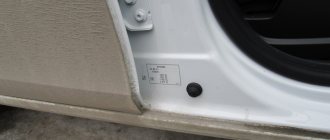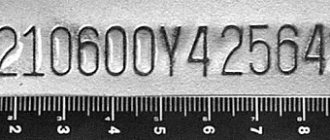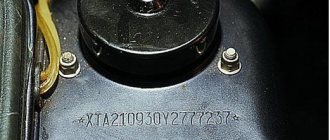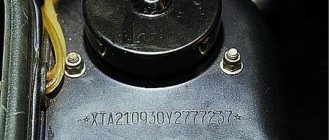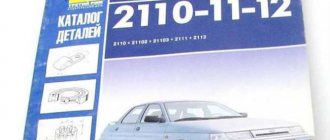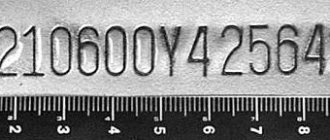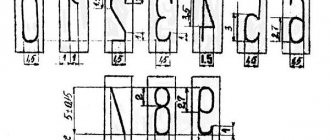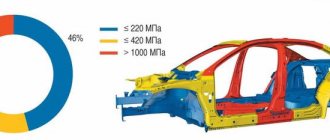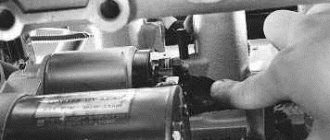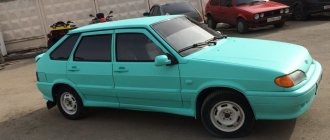Is the car engine a spare part? No, this is a numbered unit! Checking the engine number.
I often hear from drivers the careless “The engine is a spare part!” If it knocks, I’ll buy the engine from disassembly.” But today the engine number is strictly checked by a criminologist at the inspection site at the traffic police. The engine became recognized as a numbered unit. The article is required reading for all drivers who want to purchase a car on the secondary market.
1. How to check
engine number when buying a car?
2. How and what kind of engine should you buy
if it breaks down in your car?
1. When buying a car, you must definitely ask the seller to show the title and the area with the engine number. The model and its number must match the number in the documents. If the seller refuses to do this, then immediately refuse to buy such a car.
If you find that the engine number is illegible or destroyed, then it is better to choose another car for purchase, because car registration is regulated by Order of the Ministry of Internal Affairs of Russia dated June 26, 2021 N 399 “On approval of the Rules for state registration of motor vehicles and trailers for them in the State Road Safety Inspectorate of the Ministry of Internal Affairs of the Russian Federation, a sample form of a certificate of vehicle registration and invalidation of regulatory legal acts of the Ministry of Internal Affairs of Russia and certain provisions of regulatory legal acts of the Ministry of Internal Affairs of Russia,” which clearly states:
General provisions. Clause 3. Not subject to registration
in the State Traffic Inspectorate and registration actions are not carried out with vehicles on the following grounds:
signs of concealment, falsification, alteration, destruction of
vehicle identification numbers, numbers of components and assemblies (body, frame, cabin,
engine
) identifying the vehicle were detected, or forgery of submitted documents , non-compliance of vehicles and numbered units with the information specified in the submitted documents or registration data, as well as in the presence of information about the presence of vehicles, numbered units on the wanted list or the submitted documents among the lost (stolen),
with the exception
of vehicles with changed markings of vehicles funds and numbered units
as a result of natural wear and tear, corrosion, repairs or returned to the owners or holders after theft
, subject to their identification.
If you have already purchased a car with a replaced engine, then the criminologist, when registering the car with the traffic police, will write it down on a piece of paper and check it with the Ministry of Internal Affairs databases, and what car did this engine belong to? The problem is that you won’t be able to find out this information on your own in advance.
If the engine belongs to a car on which the bailiffs have imposed restrictions on registration actions
, then the inspector
will refuse to register the car
and ask you to replace the engine with another one.
If the engine belongs to a car that is on the wanted list
(that is, it was stolen), then you will go home on foot, because an employee of the Ministry of Internal Affairs will draw up a report, the car will be sent for examination, and in the future the question of
initiating a criminal case
. And it is virtually impossible to prove the fact of an honest purchase of a car. If you arrive with a stolen engine, you will be held accountable by law.
If you bought a car with an unreadable or destroyed engine number, the car will also be sent for examination, as a result of which the number will either be recognized as destroyed naturally
(corrosion, photo above), or they admit that the engine belongs to a stolen car (the consequences are also indicated a little higher)
2. A reliable and safe way to buy an engine is to purchase a contract engine
similar model with documents.
It will be legally clean, so you can safely install it in your car as a replacement for a faulty engine. After such a purchase, be sure to save the documents! When you sell a car with a replacement engine, you can show the buyer that you purchased it honestly and legally. When registering such a car, the buyer will hear from the inspector at the traffic police during the inspection of the car something like: “The engine is in order, its new number will be indicated in the “special notes” field
in your PTS.”
Conclusion: When buying a car, check its engine number. If the number differs from that indicated in the PTS, then ask the seller for documents for the engine. Refuse to buy a car: if the seller does not have such documents, if the engine number is illegible or destroyed. When purchasing an engine, avoid engines that have been dismantled without documents; invest in a contract engine.
Thanks for reading. If the article was useful, then give it a thumbs up, thereby helping other readers familiarize themselves with it. You have questions? My profile on VK, Instagram, page on Avito. Best regards, Bogdan.
Source
Vehicle registration details
Technical characteristics of cars of the Oka family
| Rice. 1.4. Identification plate: 1 – name of the manufacturer; 2 – vehicle identification number; 3 – engine model; 4 – mark of conformity with certification and code of the body that issued the certificate; 5 – manufacturer’s trademark |
The model and number of the vehicle, engine model, name of the manufacturer, options and configurations are indicated on the identification plate (Fig. 1.4).
The identification plate is secured with tear rivets in the engine compartment on the upper front cross member.
The identification number is duplicated by stamping on the rear floor cross member on the right (under the rear seat) and on the water deflector (it can be seen through the heater air intake slots on the bottom of the windshield frame).
| The engine model and number are stamped on the cylinder block. | Decoding of the identification number (XTJ11113010055709): |
– first three letters (XTJ) – manufacturer’s index:
geographical area (X - Europe);
country (T - Russia);
manufacturing plant (J - JSC "Serpukhov Automobile Plant");
– the next six digits (111130) – car model;
– (1) – code of the model year of the vehicle (see Table 1.1);
– last seven digits (0055709) – car body number.
Repair of VAZ VAZ OKA: Vehicle data sheets
Technical characteristics of cars of the Oka family
| Rice. 1.4. Identification plate: 1 – name of the manufacturer; 2 – vehicle identification number; 3 – engine model; 4 – mark of conformity with certification and code of the body that issued the certificate; 5 – manufacturer’s trademark |
The model and number of the vehicle, engine model, name of the manufacturer, options and configurations are indicated on the identification plate (Fig. 1.4).
The identification plate is secured with tear rivets in the engine compartment on the upper front cross member.
The identification number is duplicated by stamping on the rear floor cross member on the right (under the rear seat) and on the water deflector (it can be seen through the heater air intake slots on the bottom of the windshield frame).
| The engine model and number are stamped on the cylinder block. | Decoding of the identification number (XTJ11113010055709): |
– first three letters (XTJ) – manufacturer’s index:
geographical area (X - Europe);
country (T - Russia);
manufacturing plant (J - JSC "Serpukhov Automobile Plant");
– the next six digits (111130) – car model;
– (1) – code of the model year of the vehicle (see Table 1.1);
– last seven digits (0055709) – car body number.
Technical characteristics of cars of the Oka family
VAZ-1111-11113 OKA
Section 1. VEHICLE STRUCTURE General information about cars Vehicle registration data
Section 2. ENGINE Possible engine malfunctions, their causes and solutions Useful tips Replacing the coolant Replacing the engine oil and oil filter Cleaning the crankcase ventilation system Setting the piston of the first cylinder to the TDC position of the compression stroke Adjusting the tension of the camshaft drive belt Replacing the tension roller Replacing the drive belt camshaft Removal, installation and troubleshooting of the flywheel Replacement of engine seal parts Cylinder head Adjustment of clearances in the valve drive Removal and installation of the engine Engine repair Lubrication system Cooling system Exhaust system Power supply system
Section 3. TRANSMISSION Clutch Gearbox Front wheel drives
Section 4. CHASSIS Front suspension Rear suspension
Section 5. STEERING Inspection and check of the steering on the vehicle Steering column Steering mechanism Steering linkage
Section 6.BRAKE SYSTEM Checking and adjusting the brake system Replacing the brake fluid Bleeding the brake system hydraulic drive Master brake cylinder Vacuum brake booster Pressure regulator Replacing brake hydraulic hoses and pipelines Front wheel brakes Rear wheel brakes Parking brake
Section 7. ELECTRICAL EQUIPMENT Fuses and relays Generator Starter Ignition system Lighting, light and sound alarms Windshield wipers and washers Engine cooling fan Instrument cluster Switches and switches
Section 8. BODY Possible body malfunctions, their causes and solutions Replacement of buffers Hood Side door Rear door Rear view mirrors Seats Heater Body care
Applications Appendix 1. Tightening torques for threaded connections Appendix 2. Fuels and lubricants and operating fluids Appendix 3. Basic data for adjustments and control Appendix 4. Filling volumes, l Appendix 5. Oil seals Appendix 6. Layout of rolling bearings Appendix 7. Electrical equipment diagram vehicle: 1 – side turn signal repeater; 2 – front direction indicator; 3 – headlight; 4 – electric motor of the cooling system fan; 5 – sound signal; 6 – sensor for turning on the electric motor
Passport data of the car VAZ "OKA" 1111 1988-2008
- Repair manuals
- VAZ "OKA" 1111 1988-2008
- Vehicle registration details
Technical characteristics of cars of the Oka family
| Rice. 1.4. Identification plate: 1 – name of the manufacturer; 2 – vehicle identification number; 3 – engine model; 4 – mark of conformity with certification and code of the body that issued the certificate; 5 – manufacturer’s trademark |
The vehicle model and number, engine model, manufacturer's name, options and configurations are indicated on the identification plate ().
The identification plate is secured with tear rivets in the engine compartment on the upper front cross member.
The identification number is duplicated by stamping on the rear floor cross member on the right (under the rear seat) and on the water deflector (it can be seen through the heater air intake slots on the bottom of the windshield frame).
| The engine model and number are stamped on the cylinder block. | Decoding of the identification number (XTJ11113010055709): |
– first three letters (XTJ) – manufacturer’s index:
geographical area (X - Europe);
country (T - Russia);
manufacturing plant (J - JSC "Serpukhov Automobile Plant");
– the next six digits (111130) – car model;
– (1) – code of the model year of the vehicle (see Table 1.1);
– last seven digits (0055709) – car body number.
Technical characteristics of cars of the Oka family
↓ Comments ↓
VAZ-1111-11113 OKA
Section 1. VEHICLE STRUCTURE
General information about cars Vehicle registration data
Section 2. ENGINE
Possible engine malfunctions, their causes and solutions Useful tips Replacing the coolant Replacing the engine oil and oil filter Cleaning the crankcase ventilation system Setting the piston of the first cylinder to the TDC position of the compression stroke Adjusting the tension of the camshaft drive belt Replacing the tension roller Replacing the camshaft drive belt Removing, installation and troubleshooting of the flywheel Replacement of engine seal parts Cylinder head Adjustment of clearances in the valve drive Removal and installation of the engine Engine repair Lubrication system Cooling system Exhaust system Power supply system
Section 3. TRANSMISSION
Clutch Gearbox Front wheel drives
Section 4. CHASSIS
Front suspension Rear suspension
Section 5. STEERING
Inspection and check of the steering system on the vehicle Steering column Steering mechanism Steering linkage
Section 6.BRAKE SYSTEM
Checking and adjusting the brake system Replacing the brake fluid Bleeding the brake system hydraulic drive Master cylinder Brake vacuum booster Pressure regulator Replacing brake hydraulic hoses and pipelines Front wheel brakes Rear wheel brakes Parking brake
Section 7. ELECTRICAL EQUIPMENT
Fuses and relays Generator Starter Ignition system Lighting, light and sound alarms Windshield wipers and washers Engine cooling fan Instrument cluster Switches and switches
Section 8.BODY
Possible body malfunctions, their causes and solutions Replacement of buffers Hood Side door Rear door Rear view mirrors Seats Heater Body care
Applications
Appendix 1. Tightening torques for threaded connections Appendix 2. Fuels and lubricants and operating fluids Appendix 3. Basic data for adjustments and control Appendix 4. Filling volumes, l Appendix 5. Oil seals Appendix 6. Layout of rolling bearings Appendix 7. Car electrical diagram : 1 — side turn signal repeater; 2 — front direction indicator; 3 - headlight; 4 — electric motor of the cooling system fan; 5 — sound signal; 6 - sensor for turning on the electric motor
Technical characteristics of SeAZ (Oka, VAZ) 11116, 1111, 11113 - Remont-Avtovaz.ru
In 1988, an especially small class car, the VAZ Oka, rolled off the AvtoVAZ assembly line. Subsequently, production was transferred to other factories, but the Serpukhov plant became the main one, with the corresponding model designation - SeAZ. But at the same time, the name of the model, “Oka,” remained unchanged.
The first model was the basic one and it had the Oka index 1111. Subsequently, several more models appeared that received improved technical characteristics and other indices. The most popular of them were models with indexes 1113 and 11116.
Production of this car stopped in 2008. Being practically the smallest domestically produced car, the VAZ 1111 had quite good technical characteristics for its class.
Vehicle identification
Like all cars, the Oka had identification numbers applied to the body and engine. The body number was additionally an identification designation of the car itself.
The identification number was applied to the car body in three places, which eliminated the possibility of counterfeiting. The first number was applied to a special plate attached to the front of the body, in the engine compartment. This plate also carried information in the form of a code about the manufacturer; the model index and model year of manufacture were applied to it.
The identification number was additionally applied to the body under the air intake grille located near the windshield.
The third number was applied inside the cabin, on the cross member of the trunk floor.
The engine had an identification number in only one place - on the front cylinder block, next to the second cylinder.
Dimensions
All versions of the car had a monocoque three-door body, and the car was designed for 4 passengers. Despite the fact that three different models were produced, their overall dimensions were identical. The length of the car was only 3200 mm, with a width of 1420 mm, and almost the same height - 1400 mm. At the same time, the wheelbase of the Oka was 2180 mm. The ground clearance for all models was 150 mm. But they differed in curb weight: 1111 had a weight of 640 kg, 1113 had 645 kg, and 11116 had 665 kg. The use of engines with different design features had an effect.
Engines and transmissions
The Oka engine had different characteristics, depending on the model. Oka 1111 and 1113 were equipped with two-cylinder power units with synchronous piston stroke and a balancing mechanism. The power system is carburetor, cooling is liquid, and the ignition system is electronic non-contact, using a Hall sensor.
For Oka 1111, the technical characteristics of the engine were reduced to a total volume of combustion chambers of 0.649 liters and a power of 29.3 hp. In fact, it was half of the 1.3-liter engine of the VAZ-2108 model.
The SeAZ-1113 had a larger volume - 0.75 liters, and the power was also higher - 33.0 hp.
SeAZ 11116 had slightly different technical characteristics. This model, which appeared later than all others, was equipped with a Chinese power plant with 3 cylinders. The working volume of this unit was already 1.0 liter, and the power it produced was 53 hp.
Article on the topic - Design of the OKI (SeAZ) engine
All cars were front-wheel drive. On versions 1111 and 1113, a 4-speed gearbox was used, equipped with synchronizers for each gear.
The maximum speed of Oka 1111 was 115 km/h, and 1113 – 130 km/h.
The Chinese engine version 11116 was already paired with a 5-speed gearbox. This made it possible to accelerate the car to 150 km/h.
Suspension, steering, braking system
The front of the car was equipped with a MacPherson-type suspension, with telescopic shock absorbers, wishbones and a transverse stabilizer bar. At the rear, a suspension was used, consisting of shock absorbers, coil springs, trailing arms and a transverse beam.
Steering "Oka" ...
injury-proof, made of the “rack and pinion” type. The transmission of force from it to the wheels was carried out by two steering rods.
The front wheels were equipped with disc brakes...
the caliper was movable. The gaps between the caliper and the pads were adjusted automatically.
The rear wheels had drum mechanisms; the gap between the shoes and the drum was adjusted automatically. The drive of the service brakes was hydraulic, while the parking brake had a cable drive.
Article on the topic - OKA suspension: diagnostics and malfunctions
On-board electrical network…
the car was single-wire, the negative pole was the body itself. The nominal voltage in the network was 12 V. The voltage in the network was maintained by two sources - the battery and the generator.
In general, the Oka car was very interesting, but the unprofitability of production and lack of competitiveness with foreign cars of this class led to the curtailment of its production.
Video - Test drive Oka “truck” SeAZ
VAZ 11113
VAZ-1111 Oka cars and their modifications are front-engine, with a transverse engine, front-wheel drive, four-seater.
The body is two-volume, load-bearing structure, all-metal, welded.
Engines are two-cylinder, in-line, four-stroke, carburetor, 0.65 liter (not currently available) and 0.75 liter. power according to GOST 14846-81 (net) from 25.9 to 33.0 hp. Engines of the VAZ-1110 model were produced in a small batch. Cars were produced by the Kamsky (KAMAZ) and Serpukhov (SeAZ) automobile plants.
The vehicle model and number, engine model and spare parts number are indicated on the nameplate attached to the upper cross member of the radiator frame.
Vehicle and Engine Identification Numbers
- The vehicle identification number (VIN) is stamped under the air intake grille next to the windshield wiper.
- The vehicle identification number (VIN) is also stamped on the luggage compartment floor cross member.
- Vehicle information is given on a plate attached to the upper cross member of the engine compartment.
- The engine number is stamped on the front of the cylinder block in the area of the second cylinder.
Example of car data designation
- XTJ—manufacturer code;
- 11113 - car model;
- A is the model year of the car;
- 0059574 - body number.
Technical characteristics of VAZ-1111 Oka cars
Kamaz 1111-03 Oka
“Oka - conqueror of Dakar”
Inspection of the newly purchased Oka, part 3
VAZ-1111 “Oka” (SeAZ, KamAZ) (Autolegends of the USSR Issue No. 55 / Autolegends of Poland) 1:43 DeAgostini
There will be no more engine number verification
Vin code of the car VAZ 11113 Oka
OKA,Where is the mass?.3gp
Body of VAZ 1111 Oka.
What is the body number? This is a special identification code applied to the body of a specific car. The developers in this case pursued a single goal: to uniqueize the body, creating a primitive but very effective method of protection. We will learn more about the body number from the article.
Designations
The very first characters in the VIN code indicate the country of manufacture of the car, as well as the manufacturing company. Let's look at the example of Japanese cars, where the first letter in the code will be " J"
«.
For example, the combination " JT"
at the beginning of the VIN will indicate Japanese
Toyota
,
“JS” - Suzuki
,
“JN” - Nissan,
and so on.
Sometimes the manufacturer is designated not by two, but by three letters: “ JMZ” - Mazda
.
A few examples in the case of motorcycles: " JYA" - Yamaha
,
"JK" - Kawasaki
,
"JH" - Honda
.
Important:
The first letter is
“J”
only if the vehicle is manufactured in Japan. If the equipment was produced in another country, then the first symbol will be different.
In VINs of Russia
and
the USSR
the first character is
“X”
, Ukraine -
“Y”
, China -
“L”
, Korea -
“K”
, Germany -
“S”
or
“W”
.
Oka engine design
Let's now look at the structure and operating principle of the Oka engine. Let's see what the cylinder block and cylinder head of such a light engine are made of. Let's take a look inside the power unit and find out how it can consume so little fuel.
Cylinder block
Engine protection for the VAZ 11113 model is not provided by the manufacturer. Therefore, the motor is fixed on a subframe. Despite the light weight of the entire engine, its pan is made of cast iron. And throughout the structure there are cooling channels. This is a kind of jacket for cooling circulation.
The power unit is two-cylinder. Below you will find three supports for the main journals. When an engine is made at a factory, the supports are processed together with the covers. Each support has its own cover. Therefore, they cannot be changed during repair of the power unit. Refer to the marks that are on the covers and on the support.
If you install the wrong cover on the support, the crankshaft may rupture while the engine is running. The camshaft is on top. It controls the operation of four valves. There are two valves for each cylinder:
- inlet and outlet;
- inlet and outlet.
The cylinder head is completely cast from aluminum alloy. It has three specially made beds for the camshaft. They are closed with lids. This camshaft does not have bearings. Therefore, when the engine bearings wear out, the entire cylinder head should be replaced.
The intake valves on the VAZ 1111 model engine have a larger diameter than the exhaust valves. This structure facilitates better filling of the cylinders with the fuel-air mixture.
The cylinder head is attached to the BC using six bolts. When tightening, experienced mechanics recommend tightening them crosswise. This way you will avoid distortion of the cylinder head of the Oka engine.
The gas distribution mechanism is also made of cast iron. The manufacturer carefully processed the cams and necks. The camshaft is driven by a special pump. An eccentric is installed on the rear of the vacuum pump to ensure proper operation of the camshaft.
Thermal clearances of the valves are regulated by special washers. This procedure is done manually every 100 thousand kilometers.
The gaps are adjusted either independently by the car owner or at a service center by an experienced mechanic. The procedure is carried out only on a cold engine. The procedure consists of the following steps:
- Remove the air filter.
- Cover the carburetor with a rag.
- Remove the cylinder head cover.
- Turn the crankshaft. To make this process easy, engage first gear and remove the first cylinder spark plug.
- Check to see if the mark on the alternator pulley and the front cover match.
- Measure the thermal gap.
- Secure the device to the lid.
- Put the washers on and spin them.
- They press on the lever and press the pusher.
- The clamp is used to secure the camshaft.
- Remove the adjusting washer.
- Install a new one into the pusher and repeat all steps in reverse order. Pre-calculate the thickness of the required washer.
- Rotate the crankshaft and adjust the thermal gap.
- Assembling the engine.
The crankshaft is cast from cast iron with an admixture of magnesium. It consists of three main journals and two connecting rods. Shaft cheeks – 4 pieces. They serve as counterweights and also reduce vibration of the Oka engine during operation.
The front part of the crankshaft is made to accommodate the timing gear, and the drive pulley from the generator. The flywheel mounting flange is located on the rear side. The gear of the balancing shafts to which the flywheel is attached is also located here.
Attention! When the teeth on one side wear out, the flywheel can be turned over to use the other part of the teeth. Balancer shafts reduce engine vibration.
Cylinder-piston group
The pistons are cast from heat-resistant material. This cylinder is additionally subjected to high temperature treatment. The bottom of the device is completely plastic. Such cylinders are also called plug-in cylinders.
There are only three rings. Two compression and one oil scraper. The first rings create a seal in the combustion chamber of the VAZ 1111 model engine. They also participate in heat removal. For example, they transfer heat from the top of the cylinder to the walls.
The oil scraper ring has a special expander. It makes it possible to increase the area of the ring and come into contact with the walls.
Let's look at the modifications to the Oka engine.
- 1111. This is the first motor model. It was created by dividing the VAZ 2108 engine into two parts. Volume 650 cubic centimeters. When considering engines from Oka, they take it as an example, which is what I did above;
- 11113. It was created by modifying the first model. The engine has become a little more powerful. Despite the increased power, it became hotter, and the environmental class remained the same - euro 0.
Now let's talk about the shortcomings of the Oka engine.
VAZ engine number
The marking on the engine is applied to a special area of the cylinder block. The labeling process is mechanized.
On engines produced before December 1974 (VAZ-2101, VAZ-2102, VAZ-2103), the marking area was located on the front upper end of the cylinder block.
Since the second half of 1975, the marking area on engines has been located on the tide of the block, to the left in the direction of travel, above the oil filter. On engines manufactured from December 1974 to July 1975, markings are found on both sites. Since July 1975, at the previous location of the engine number, only the engine technological number, consisting of three digital characters, has been applied.
Photo. General view of the number applied to the engines of VAZ-2101-VAZ-2107 cars.
Markings are applied to engines of all models, except the VAZ-2108, using an automatic German numbering machine, as well as a VAZ KVTs numbering machine. On the engines of VAZ-2108 cars, markings are applied with a numerator.
Rice. Engine numbers, made on a metal plate with a numerator: a) - ; b) — VAZ KVTs; V) - . The sizes of this font and stamp imprints are shown in the figures.
Rice. Custom non-guest font options
Rice. Sign imprints made on a metal plate
On engines of VAZ-2108 and VAZ-2109 cars and their modifications, the number is located on the upper part of the rear wall of the block on the flywheel side, to the left in the direction of travel (close to the distributor breaker).
The surface of the site is subjected to mechanical processing on a milling machine before marking is applied. On the engine blocks of VAZ-2101, VAZ-2102, VAZ-2103, VAZ-21011, VAZ-2104, VAZ-2105, VAZ-2106, VAZ-2107, VAZ-2121 and their modifications, not only the platform for markings, but also surfaces for the oil filter and fuel pump.
The location of the number on the site relative to its conventional center or boundaries is not regulated.
VAZ engine markings
On domestic Russian cars of the VAZ family, engine location numbers can be found:
- on the right wing, in the area of the mudguard;
- in the bottom luggage compartment on the right;
- At the bottom of the driver's seat there is general information with the engine number.
Decoding of VAZ engine number markings:
- XTA - manufacturer's code.
- 212241 — modification of the brand (model);
- 1 - year of manufacture of the car;
- 1594535 — car body number;
- 212241 - number of the power unit;
- 1655 kg - maximum permissible weight while driving;
- 2284 kg - maximum permissible weight with trailer;
- 1-795 kg - maximum load on the front axle of the vehicle;
- 2-855 kg - maximum permitted load on the rear axle of the vehicle;
- 25 — marking option;
- 015 — packaging code;
- 1508838 - code for spare parts.
Explanation of OKA car markings:
1 — name of the manufacturer; 2 — vehicle identification number; 3 — motor model; 4 - a sign that meets the certification requirements and the code who issued this certificate; 5 - trademark of the manufacturer.
This is what the plate with the code for LADA Kalina looks like:
This is a Nissan car designation plate:
Toyota engine number location:
Markings under the hood of an Opel car:
About the sign
A duplicate data plate is required on any vehicle, as it allows you to find important information in the event of damage and unreadability of the main plate.
Number in rust
To be precise, Vin is mostly applied to the following areas of the car.
- Body. As a rule, if we are talking about a “passenger car”, then in 2 places of the car frame - on the front and rear.
- If it is a bus, then the plate with the number is again applied to the body, only in this case in different places (as a rule, again 2 places).
- If it is a trolleybus, then Vin is applied only in one place of the body.
- As a rule, on the cabins of trucks and forklifts the plate is knocked out in just one place.
- If we are talking about a semi-trailer and motorized vehicles, again, the plate is knocked out in one place.
- On SUVs, forklifts and trolleybuses, the plate can be stamped on a separate area.
The passenger car plate, stamped on the front of the body, should contain as much information as possible. In particular, there must be information about the car model, body make, engine, permissible weight, and so on.
The engine number of the car is not readable, what awaits you.
If for some reason the number is not readable. History based on personal example.
For example, a common cause is deep pockets of corrosion. This is a natural reason. The number is stamped on the engine body, which constantly operates in a different temperature range and is constantly exposed to an aggressive environment (salt, sand, various reagents from the highway, water, etc.)
The number simply becomes corroded and becomes unreadable.
Cleaning the engine number helps 50%, but you should be very careful with this procedure.
If even after cleaning the number is not readable, you will be sent for examination. At the same time, the MREO will take away your PTS and seize your registration actions, i.e., and send a complaint (something like a trial with the cops that the engine is not stolen and is not listed in the cops’ databases)
The car remains with you, but you cannot sell it or leave it as collateral; problems may also arise with the inspection and, in general, with subsequent operation. If the engine was actually purchased from a stolen car, criminal proceedings will be initiated.
Therefore, when purchasing a car, always pay attention to this seemingly insignificant detail so that it does not turn into trouble. Usually everyone checks the body, but you shouldn’t forget about the engine.
Next, you sell your documents for examination and they assign you a day and time of arrival at the station. Usually this happens within a week, for example in Bryansk this procedure is free, but the queues will take time. After you have passed the examination, all you have to do is wait. I waited a whole month. The results are sent by mail to the MREO and to you at the owner’s place of residence. Until the head of the MREO signs them, you shouldn’t even go there, just call and wait. Then you call and they tell you that the results have arrived. You create an application on the government services website to make changes to the PTS. Pay the fee and make an appointment for a date/time convenient for you, write an application to the observation deck. It is better to arrive for the inspection earlier than the time specified on the coupon; upon arrival at the site, you name the date when you were sent for examination, the employees find in their notes a note that everything is normal and there is no external interference, referring to the examination that you did. They write to you that the number is not readable and was lost due to natural reasons. With this inspection, you go directly to the MREO building using the certificate that you took from government services and submit all the documents to make changes to the PTS. They make a mark in your PTS and change the STS, this is standard. In the PTS they write that the number is not readable and they prescribe all sorts of crap. And most importantly, the ban on sales is lifted. From now on you can sell and buy your car
.
If you encounter this problem when selling and the person has been waiting all this time, then you can not immediately make changes to the title but carry out the purchase and sale and then you will save on duties.
I encountered this problem when I sold my grant. I was the only owner and for 7 years the number was simply eaten up by corrosion. We found a buyer and agreed on everything, but during inspection the engine number did not pass and we had to cancel the deal. It was very unpleasant, but since I knew that nothing had been done to the engine, I didn’t worry too much. I spent a lot of time, about 1.5 months. It’s clear that I didn’t wait to buy the original one, and after receiving a letter from the examination, I simply put the car up for sale again and within 2 days a new buyer was found. I immediately explained everything to him and said that the car was currently under arrest due to the engine being unreadable, but I passed the examination and there were no complaints about it. We immediately went to the MREO and on the same day made changes to the title and changed the owner. But I didn’t sell the car urgently, and if I had to it would have been a very big problem.
I also knew that nothing criminal had been done to him, so I advise you, as car buyers, to pay attention to this before buying, but it is better to go to the MREO together with the seller and transfer the money after passing the inspection at the site,
so as not to get caught up in the examination yourself and sit biting your nails wondering what’s wrong with the car.
Source
THIRD ATTEMPT
The new prototype, codenamed “Oka-3” (), is modestly hidden in the corner of the showroom of the AVTOVAZ Scientific and Technical Center. The car was not shown to a wide audience. What about the outside public - even the majority of VAZ workers don’t know that work is being done in this direction! It is clear that these are difficult times for the company. Not long ago it was officially announced that work on “Project C” would be temporarily stopped. But, unlike this development, Oka-3 is based on an existing platform, it uses serial units, so the path to the assembly line can be very short. And the existing prototype is not plasticine, but a running one. They even gave me a ride. You feel like you’re driving a full-fledged car, but it’s unusual to back up - it seems that you can reach the glass of the third door with your hand. In general, the same “Kalina”, only a little shorter.
"Project 11174"
Only here you need to understand who might like the new three-door. Its main advantage is the combination of comfort (for the driver and front passenger) of higher-class models with the small overall dimensions of a city car. Who would want to buy one? For example, a young man or girl for whom this is their first personal car. Thanks to its low price, it can attract, on the one hand, potential buyers of the “classic” and “Samara”, and on the other, everyone who previously chose the “Oka”. In addition, there is a chance to lure some of the customers of car dealerships, where they offer the cheapest foreign cars (Daewoo Matiz, ZAZ-Chance). In addition, rich versions may be of interest to those who traditionally choose VAZ three-door cars. With a 16-valve engine producing 89 hp. The car has good dynamics for the city.
